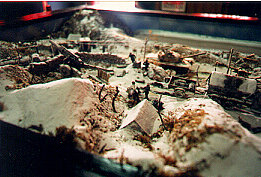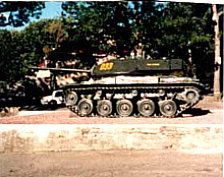



WELCOME TO THE MARINE CORPS LEAGUE MUSEUM..... A PICTORIAL WALK INTO THE HISTORY OF THE "UNITED STATES MARINES" IS FEATURED HERE OF DIFFERENT ERAS. OR COME VISIT US AT OUR LOCATION IN SCRANTON,PA.......COME BACK OFTEN FOR A VISIT , WE ARE FORE EVER ADDING NEW ARTIFACTS TO YOUR MUSEUM...SEMPER FI

THE MCL BUILDING WAS BUILT IN 1936 BY W.P.A., THE COMPLETION OF THE MUSEUM WAS 1982. YOU WILL FIND THE MUSEUM LOCATED INSIDE THE MARINE COPRS LEAGUE BUILDING. ALL DIORAMAS WERE BUILT BY "JERRY MAUS SR.". MR MAUS WHO SERVED WITH THE UNTIED STATES ARMY, HAD GREAT RESPECT FOR THE MARINE CORPS...........OUR THANKS AND APPRECIATION GOES TO "MR. JERRY MAUS SR.".

MUSEUM OFFICERS ; George Kopestonsky, Leo Withline, Bob Tuffy and Dominic DeNunzio. Anyone that wishes to donate items or photos to add to existing display here on this web site may contact: Dominic DeNunzio 2074 Mossy Oak Circle Clarksville, Tn. 37043 Or call: (931) 906-8998 or Email to:usmcrd@charter.net

Photo Caption: First Lieutenant Baldomero Lopez, United States Marine Corps, scales the sea wall at Red Beach during the Inchon Landing, Sept. 15, 1950. Minutes after this photo was taken, Lopez sacrificed his life to save his own men and earned the Medal of Honor.
On June 25, 1950, eight divisions of the North Korean People's Army, equipped with Soviet tanks, mobile artillery and supporting aircraft, crossed the 38th parallel and invaded the Republic of Korea. On June 27, the United Nations (U.N.) Security Council proclaimed the North Korean attack a breach of world peace and requested member nations to assist the Republic of Korea.
On June 30, President Harry S. Truman ordered a naval blockade of the Korean coast and authorized the Commander in Chief Far East, General of the Army Douglas A. MacArthur, to send U.S. ground troops into Korea. On July 2, MacArthur recommended that a Marine Corps regimental combat team be deployed to the Far East. The Joint Chiefs of Staff approved his request the following day.
On July 7, the 1st Provisional Marine Brigade was activated at Marine Corps Base Camp Pendleton, Calif. The core of the ground element was the 5th Marines, while Marine Aircraft Group 33 made up the air element of the brigade. Just five days after its activation, the 1st Provisional Marine Brigade, with a strength of over 6,500, sailed from San Diego en route to Pusan, Korea.
The first elements of the brigade came ashore at Pusan on Aug. 2. The next day, the first Marine aviation mission against North Korea was flown from the USS Sicily (CVE-118) by gull-winged Corsairs of Marine Corps Fighter Squadron 214 (VMF-214) in a raid against North Korean installations. They were subsequently joined by Marine Fighter Squadron 323 (VMF-323), flying from the USS Badoeng Strait (CVE-116). The two squadrons harassed enemy positions and installations near the city of Seoul and close to both the 38th parallel and North Korean Army supply lines. The 1st Marine Division spearheaded the assault. The attacking force had to navigate a narrow channel with swift currents and horrendous tidal changes, while dodging islands and potential coastal defense battery sites. Final approval for the operation, code named CHROMITE, was not given until Sept. 8. (See separate Fact Sheet on Operation CHROMITE.)

Photo Caption: U.S. Marines of the 1st Marine Division Reconnaisance Company make the first helicopter landing on Hill 812, to relieve the ROK 8th Division during the renewed fighting in Korea. Sept. 20, 1951 |
The Landing at Inchon
On Sept. 15, the 1st Marine Division, under the command of Major General Oliver P. Smith, led the first major U.N. force strike in North Korean-occupied territory, with a surprise amphibious assault at Inchon. In five days of textbook-style campaigning, the division closed on the approaches of Seoul, the South Korean capital. In house-to-house fighting, the Marines wrested the city from its communist captors by Sept. 27. On Oct. 7, 1950, with North Korean forces in full retreat, the Inchon-Seoul campaign was formally declared closed.
Marines at the Chosin (Changjin) Reservoir
In late October, the 1st Marine Division landed at Wonsan and spread out to secure the approaches to the port city. The division was then ordered to advance northwest of Hungnam along a mountain road to the Chosin (Changjin) Reservoir, the site of an important hydroelectric plant. The Marines would then advance to the Yalu River — the border between North Korea and the People's Republic of China.
Despite intelligence in early November that Chinese communist forces had massed on the Korean side of the Yalu, the 1st Marine Division was ordered to continue its progress northwest from Hungnam to the Chosin Reservoir. The brief autumn weather was almost over, and temperatures were turning bitterly cold. On Nov. 27, elements of the Chinese Communist People's Liberation Army struck Marine positions in force. In a carefully-planned counterstroke, eight Chinese divisions charged down from surrounding mountains with the sole mission of destroying the 1st Marine Division.
Over the next four weeks, the Chinese and Marine Corps forces engaged in some of the fiercest fighting of the Korean War. In an epic movement, the 1st Marine Division completed a successful fighting withdrawal through 78 miles of mountain road in northeast Korea. The fighting withdrawal ended in mid-December with the amphibious evacuation of the Marines from the port of Hungnam, Korea. Although suffering more than 4,000 battle casualties and uncounted incidents of frostbite, Marine Corps air and ground units killed nearly 25,000 Chinese communist troops.
After Chosin (Changjin)
During the first three months of 1951, the 1st Marine Division participated in several U.N. offensive operations, first against North Korean guerrillas and later participating in an advance through the mountains of east-central Korea. From late April to early July, the division took part in the U.N. defense against a Chinese communist spring offensive, in which U.N. forces faced nearly 500,000 enemy soldiers. The Chinese offensive ended in mid-May with heavy enemy losses.
The 1st Marine Division then participated in the U.S. Eighth Army drive northward past the eastern tip of the Hwachon Reservoir. By June 20, 1951, the division had taken its objective — a ridgeline overlooking a deep circular valley in the Korean mountains nicknamed the "Punchbowl." Truce negotiations soon began, and the U.N. forces settled down into a defensive line.
The winter of 1951–52 found the 1st Marine Division deployed along an 11-mile front just north of the Punchbowl. In mid-March, the division was reassigned from the X Corps' eastern position in Korea, to the I Corps area at the far western end of the U.N. line. On March 24, the division assumed responsibility for approximately 35 miles of the front, which overlooked Panmunjom and included the defense of the Pyongyang–Seoul corridor. The pace of the war now slowed, with small, localized actions replacing the earlier, large-scale offensives.
The relative quiet on the front was rudely shattered in late March 1953 when Chinese forces mounted a massive offensive across the U.N. front line that hit 1st Marine Division outposts in the right sector. On March 26, enemy forces attacked outposts "Reno," "Vegas" and "Carson" — the so-called Nevada Cities Campaign. All outposts were manned by the 5th Marines. In particularly bitter fighting, Outpost Reno fell to the enemy, but the stubborn 5th Marines maintained control of Vegas and Carson. Marine Corps casualties totaled more than 1,000, with communist losses at least twice as high.
During the first week of July, combat outposts Berlin and East Berlin in the 7th Marines right regimental sector came under attack during the Marines' relief of the U.S. Army 25th Infantry Division. The Marines did not concede any key terrain, and at 10 p.m. on July 27, 1953, the lengthy truce negotiated at Panmunjom finally went into effect, ending three years of fighting in Korea.
The price of liberty in human costs is always high, and the Korean War was no exception. Marine casualties totaled roughly 28,000; more than 4,200 Marines gave their lives in Korea. Forty-two Marines were awarded the Medal of Honor; 27 of these awards were posthumous. Additionally, 221 Navy Crosses and more than 1,500 Silver Stars were awarded to Marines.
Marine Corps Aviation
During the Korean War, units of the 1st Marine Aircraft Wing flew more than 118,000 sorties in support of U.N. forces. Almost 40,000 of these sorties were close-air support missions. Marine helicopter squadrons evacuated more than 10,000 wounded personnel and greatly increased the survival rate for wounded Marines.
Reserves
In 1950, the Korean War saw the Marine Corps expand from 75,000 regulars to a peak strength of 261,000 Marines, most of whom were reservists. Complete mobilization of the organized ground Reserve had been accomplished in just 53 days, from July 20 to Sept. 11, 1950. Of the Marines participating in the Inchon invasion, 17 percent were reservists. By June 1951, the proportion of reservists in Marine Corps units in Korea had increased to nearly 50 percent, and during the war, 48 percent of all 1st Marine Aircraft Wing combat sorties were flown by Marine reservists. Between July 1950 and June 1953, about 122,000 reservists, both recruits and veterans, saw active duty with the Marine Corps.
Growth of the Marine Corps During the Korean War
The Marine Corps emerged from the Korean War with the highest sustained peacetime strength in its history. The suddenness of the war, and MacArthur's immediate request for Marines, had emphasized the importance of maintaining the Corps as a ready striking force. The fiscal end strengths of the Marine Corps during the Korean War and immediate post-Armistice period were as follows:
| Year |
Officers | Enlisted | Total |
| 1950 | 7,254 | 67,025 | 74,279 |
| 1951 | 15,150 | 177,770 | 192,920 |
| 1952 | 16,413 | 215,544 | 231,957 |
| 1953 | 18,731 | 230,488 | 249,219 |
| 1954 | 18,593 | 205,275 | 223,868 |
Casualties
The war in Korea was costly. The total U.S. casualties during the war numbered approximately 140,000 killed, missing in action and wounded. Marine Corps casualties from August 1950 to July 1953, were as follows:
Dead* |
Wounded | Total |
| 4,267 | 23,744 | 28,011 |
* The total under "Dead" includes killed in action, died of wounds, captured and died, missing in action and presumed dead.
For additional information contact:
Marine Corps History and Museums Division
Building 58, Washington Navy Yard
1254 Charles Morris S.E.
Washington, D.C. 20374-5040
The sources used are located in the Reference Section of the Marine Corps History and Museums Division.
